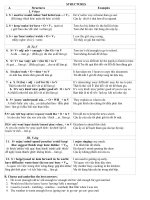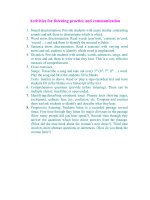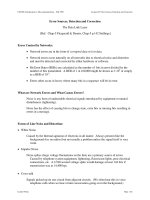Freewriting, Prompts and Feedback.doc
Bạn đang xem bản rút gọn của tài liệu. Xem và tải ngay bản đầy đủ của tài liệu tại đây (86.03 KB, 8 trang )
Freewriting, Prompts and Feedback
Kenneth J. Dickson
Chinese Culture University (Taipei, Taiwan)
Introduction
Playing chess requires precision, mistakes are obviously penalized, and you have to know
what your strategy is, otherwise you will lose the game. However, using these skills when
facing a blank page can be quite counterproductive, creating frustration, disappointment,
and even resentment among students when they attempt to write fluently.
Freewriting can help students overcome the sense of block. Jacobs outlines the nature of
freewriting as having three important aspects "concentrating on content, not worrying about
form, and writing without stopping" (Jacobs, 1986). As such, freewriting offers a student-
centered activity that can benefit writing class students significantly by helping ease their
expectations of themselves and their writing while at the same time increasing their sense
of motivation to write in English. This article outlines the basic method for freewriting,
introduces variations, and details practical ways to make the best of freewriting. This type
of exercise encourages students to overcome their reticence in writing by providing both
the opportunities and stimulation to write.
I. What is 'Freewriting'?
Freewriting is an opportunity for students to write freely for a brief period in each class,
usually 10 minutes or thereabouts. This offers students a rewarding experience of writing
because it can avoid the inhibitions which normally influence writing, inhibitions that have
developed since first grade of elementary school, i.e. writing had to be clear, correct and
neat. ESL students especially can benefit as their level of competency develops. To be
successful, though, freewriting, while free for the students, still requires the teacher to be
organized, disciplined and methodical.
Method
At the beginning of each class, allocate about 15-20 minutes for the whole freewriting
exercise. The basic process can be broken down into four steps.
1. Preparing for writing
Students must prepare a piece of paper, or a notebook, and a pen. Freewriting is usually
best done as the first activity in class because other activities, anxiety over assignments,
and classroom stress may all interrupt or even hinder the creative process. Freewriting
needs space, time and a certain degree of freedom from anxiety.
2. Setting up the task
Jacobs advises nine basic criteria for freewriting in an ESL environment (284) while Elbow
describes clearly and simply the philosophy of freewriting in Writing Without Teachers:
"The idea is simply to write for 10 minutes ... Don't stop for anything. Go quickly without
rushing. Never stop to look back, to cross something out, to wonder how to spell
something, to wonder what word or thought to use, or to think about what you are doing. If
you can't think of a spelling, just use a squiggle or else write, 'I can't think of it.' Just put
down something. The easiest thing is just to put down whatever is in your mind. If you get
stuck it's fine to write 'I can't think of anything to say, I can't think of anything to say' as
many times as you want; or repeat the last word you wrote over and over again; or anything
else. The only requirement is that you never stop." (3)
3. Freewriting
Initially the teacher may provide an example of what to do themselves by sitting in front of
the class and doing the same task. However, the other role as facilitator of freewriting is
also important. Ensuring that students aren't correcting, changing what they wrote,
consulting their dictionary, or one of the hundred and one other activities that distract or
interrupt students writing. Moreover, merely acting as an encourager can also provide
students with the necessary reminder to remain focused on the task at hand. This is not a
test, but it does require concentration. An involved teacher can play an important role, here.
4. Post-writing
Warning them that the time is up about 2 minutes before the end helps to round up the class
activity. Students write their name at the top and may be asked to note the number of words
in that particular freewriting. The teacher can collect paper or notebooks for later reading
although no explicit correction or grading should be carried out on the papers. Freewriting
like this may form an important element of a portfolio of writing.
Follow-up Suggestions
If this is the first time for freewriting, a survey or short discussion afterwards may provide
the teacher with extra opportunities to explain any aspects that are still unclear, deal with
reactions to the exercise, and handle any difficulties that arose. In general, freewriting
needs to be done regularly throughout the semester to foster more involvement from the
students. Elbow reckons three times a week as the minimum (3). However, most class
schedules are less frequent than that. Students can be encouraged to write more frequently
in their own time, perhaps even keeping a journal. Increased frequency of writing should at
the very least resolve most of the difficulties in the early stages. Outstanding problems,
however, may persist.
II. Dealing with Problems
Five different kinds of writers suffer problems during freewriting. Identifying the
symptoms will help you spot those having difficulty with the task and allow you to provide
an appropriate solution for them.
The reluctant writer
• Symptom: This writer stops repeatedly, writes briefly, and is always looking
around. He/she never seems to concentrate for more than a few seconds at a time.
• Solution: Gentle encouragement to return to the task at hand and a reminder that
perfect work is not expected will both usually work.
The always-has-to-be-correct writer
• Symptom: The use of an eraser, liquid paper or scoring out of whatever has been
written indicate a writer with perfectionism as his/her ideal.
• Solution: Reminding writers that they do not have to be perfect in this task, they
just have to complete the task by writing down their stream of consciousness
thoughts. Asking them to put away these devices or to stop deleting what they write
should also work well.
The keyboard tapper
• Symptom: Frequent use of the pocket electronic dictionary (or flipping of
dictionary pages) indicates someone pursuing the most accurate word possible.
• Solution: Ask them to put away the dictionary, to paraphrase any word they don't
know, or leave a space or write the word in their own language. Remind them just
to keep writing until the task is finished. All of these will help remedy this
situation.
The talker
• Symptom: Since a quiet class is usually required for this task, the talker is
immediately noticed above the silence of the classroom, either as the buzz from the
back of the class or audible words coming from the corner.
• Solution: Ask this writer to capture on paper some of the thoughts that are being
expressed verbally, since he/she seems to have a lot to say.
The copier
• Symptom: This writer has another piece of paper on which is written a topic, title
and even some notes or a plan. He/She can be seen copying or referring to it
frequently.
• Solution: This writer obviously feels that he/she can't write well and so needs some
linguistic or content-based support for the writing. However, this defeats the point
of freewriting, that it is unprepared, open-ended and flowing, in all three aspects
that are essential to freewriting. A suggested way to deal with this might be to talk
to the writer about his or her concerns and find out why they feel it is necessary to
do prepare this. You might also need to reassure them that their writing is good
enough for freewriting since the aim is merely to write something, not to write a
perfect composition.
Reminding students of the purpose and method of freewriting from time to time is an
effective strategy to solve a lot of the problems that appear. An observant and pro-active
teacher can easily solve most of the problems that occur in freewriting.
III. Post-writing Activities: Prompts
Three variations on the basic technique that have proved successful in my classroom
include using prompts, encouraging sharing, and varying feedback.
Writing Prompts
In freewriting, some students do report negative experiences, mostly complaining that they
do not know what to write. In these situations, a stimulus or prompt can be very helpful to
start writing. However, these 'prompts' are not topics, in other words, they do not set down
limits to what can be written about. They are merely places to start writing, and if the
students end up writing about something completely different, the freewriting exercise will
still have been completely successful.
There are a number of prompts that have worked well in my class. So, set aside a time at
the beginning of the writing session and use it to present the stimulus for writing. Present
the instructions and prompt clearly to students. Either during or after the prompt, the
students can begin writing. Students should not worry about whether they understand
everything they heard or saw; rather they should allow the prompt to inspire or stimulate
their writing. They do not even have to keep to the topic, they just have to let the writing
take over. Open-ended prompts also tend to work better as they allow students to explore
the range of responses possible.
1. Quotation
A quotation, if it has a strong theme or provokes a strong response, provides a good prompt
for students to explore. Choose quotations that should be easy for your particular students
to understand. There are many websites with databases of quotations available, including
Quoteland, which can be found at and Familiar Quotations
from Bartlett's, Simpson's and Columbia all of which are at
2. Short story
A short story can be read out to the class. Perhaps it will be familiar to students already in
their first language, such as one of Aesop's fables. Keep the story time limit to less than
five minutes. Even an interesting chapter or part of a story that inspires can be chosen from
a longer book.
3. Music
Music works very well as a prompt, because it allows space for the imagination to grow
and develop during the freewriting time, as well as provides a break from the monotony of
the teacher's voice. However, avoid songs with lyrics because students may become
frustrated with trying to comprehend the lyrics. The lyrics themselves may also lack
subtlety, thus limiting the range of responses students may have.
4. Memory
Think of a powerful memory that you have. Set the scene by sharing your memory with the
class. Elicit other kinds of memories from students, e.g. from childhood, a trip, even a
person in their lives. Then tell students to share a memory that had a powerful effect on
them.
5. Picture: piece of art or photograph or abstract drawing.
Again, a picture that can stimulate a variety of responses will work better than one that
demands a 'correct' interpretation. Abstract art may work better than traditional art. Simple
sketches can also be very effective in creating a variety of responses, since interpretation
remains open for the writer.
6. Question
A provocative question can also be a good stimulus for writing. Find a question that
provokes your students into responding in writing, but also one that allows students a
variety in the type of responses. This gives them freedom in what to write, while avoiding
numerous pieces all dealing with the same ideas and content in more or less the same
fashion.
7. Poetic license
A short poem that has a strong theme may also work. Do stress to students that they do not
need to give you the correct interpretation, but just ask them to respond however they like.
8. Video segment
A good video segment or situation that presents itself, such as a scene from a movie that
most of the class have seen, or a scene in which the situation is obvious. Again avoid
closed situations where there are only a few possible stances, as this will help students to
focus on expressing their ideas and interpretations.
9. Odd predicaments
An open-ended situation can present an ideal opportunity for students to react in an
unhindered way. You can use a 'what if' scenario, such as 'What if you woke up tomorrow
morning and found you had been turned into a dog'; or an ethical dilemma like 'You see a
poor woman stealing in a store, what would you do?'; or even a situation that happened to
you in real life, but posed as a question.









